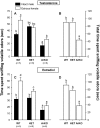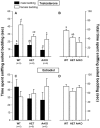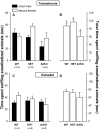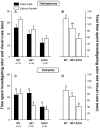The aromatase knock-out mouse provides new evidence that estradiol is required during development in the female for the expression of sociosexual behaviors in adulthood
- PMID: 12388618
- PMCID: PMC6757696
- DOI: 10.1523/JNEUROSCI.22-20-09104.2002
The aromatase knock-out mouse provides new evidence that estradiol is required during development in the female for the expression of sociosexual behaviors in adulthood
Abstract
We used estrogen-deficient aromatase knock-out (ArKO) mice to determine whether estrogens contribute to the development of the brain and behavior in females. Female mice of three different genotypes [i.e., wild type (WT), heterozygous (HET), and homozygous (ArKO)] were ovariectomized in adulthood and subsequently tested for odor preferences (choice: intact male vs estrous female) in a Y-maze. When treated with testosterone, ArKO females spent significantly less time sniffing odors (both volatile and nonvolatile) from either male or female stimuli compared with WT and HET females. When given direct access to anesthetized stimulus animals or when given a choice between odor and visual cues from both stimulus animals, ArKO females continued to spend less time investigating the stimuli compared with WT and HET females. These defects in olfactory investigation of ArKO females were partially corrected with estradiol treatment in adulthood. Estradiol-treated ArKO females no longer differed from WT and HET females in the time spent investigating either nonvolatile odors or the anogenital region of anesthetized animals. However, ArKO females still investigated volatile odors and/or visual cues less than WT and HET females. Sexual receptivity was severely impaired in ArKO females after treatments with estradiol and progesterone that successfully induced receptivity in WT and HET females. Furthermore, ArKO females showed diminished levels of male sexual behaviors, whereas WT and HET females readily mounted an estrous female. Together, these findings demonstrate that estrogen is required for normal female development. The concept that the female brain develops in the absence of any hormonal stimulation should therefore be reconsidered.
Figures






References
-
- Baillien M, Bakker J, Honda S, Harada N, Balthazart J. Aromatase activity in the brain of wild-type and ArKO mice. Soc Neurosci Abstr. 2002;28:383.4.
-
- Bakker J, van Ophemert J, Slob AK. Organization of partner preference and sexual behavior and its nocturnal rhythmicity in male rats. Behav Neurosci. 1993;107:1049–1058. - PubMed
-
- Bakker J, van Ophemert J, Slob AK. Sexual differentiation of odor and partner preference in the rat. Physiol Behav. 1996;60:489–494. - PubMed
-
- Bakker J, Honda S, Harada N, Balthazart J (2002) Sexual partner preference requires a functional aromatase (Cyp19) gene in male mice. Horm Behav, in press. - PubMed
-
- Baum MJ. Differentiation of coital behavior in mammals: a comparative analysis. Neurosci Biobehav Rev. 1979;3:265–284. - PubMed
Publication types
MeSH terms
Substances
Grants and funding
LinkOut - more resources
Full Text Sources
Other Literature Sources
Molecular Biology Databases
